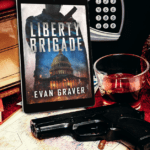
Writing. It’s tough. Especially when you’re a pantser. Here’s my tips to help you get through that muddy middle to finished first draft.
When I tell people I’m working on my thirteenth book in The Ryan Weller Series and that I have three other books written but not published (different series) they always ask how I come up with story ideas or if I plot everything out or just come up with things on the fly.
Let me pull back the curtain.
I’m a total pantser.
I sit down every morning with no clue what to write or what the characters are going to do. They tell me as I write. Does that mean I have multiple personalities? I feel like I should come into the office to WWE wrestler Randy Orton’s theme music, “I hear voice in my head. They talk to me. They understand.”
Okay, back to the topic at hand. To start a story, I often comb through news articles, especially in the Caribbean, or I might have hit upon a story idea when writing the last book and its been percolating in the back in my mind. Then I sit down at the computer and start typing.
That doesn’t mean the story flows seamlessly out. I usually hit a wall about 30 to 40K into the book, then I have to step back, reread, reevaluate, and make some notes on where I want the story to go and how its going to end. Taking notes, doesn’t mean an outline.
For me, they’re more like bullet points with highlights to hit and sometimes they get scratched off because like I said, the characters do what they want. For instance, I keep trying to get Ryan into the Fort Lauderdale area to settle down a bit, but he keeps getting on his sailboat and disappearing over the horizon. He told me, “You might be settled there, but I’m free to do what I want.” My alter ego has an ego.
So where does this wandering rant lead?
Let’s break it down. There’s two types of writers. Those who plot and those who write by the seat of their pants. You know where I stand, (okay, sit, you got me – that’s a wheelchair joke).
I find many writers are pantsers, but they can’t finish a novel. They often start, get a few chapters in, and don’t know where the book is going or how it will end, often rewriting the same chapters over and over before starting a new project.
For me, I find that not knowing what exactly will happen next is sometimes the best way to write, but knowing how the book will end will definitely help you to finish that project.
Plotters like to outline their projects, know how the book will start and end, often outlining what will happen in each chapter, have researched everything before hand and have copious notes on characters, character development, and descriptions of people, places, and things nailed down cold.
My brain doesn’t operate like that. I’m not a numbers guy or an outline guy, but …
Here’s what I do if you get stuck in the middle of your project.
- Take a step back and view the work in progress as a whole.
- Jot down bullet points of where I think the story will go and how it will end. (remember you don’t have to adhere to all of these notes)
- Do some research about where the book is set, the time period, the people and technology the characters might interact with.
- Make notes about these things. Sometimes having that research written down is enough to jump start that spark.
- If I’m still not there, I’ll just start writing. Pick a different place in the story and then go back and fill in the gaps.
While I agree that one should know the basic arc of the story, I don’t agree that one has to follow an outline specifically. Over the course of writing 16 novels and many short stories, I’ve learned what works for me and what doesn’t. That doesn’t mean I don’t have to go back and rewrite sections of the book when I realize its not the story line I want to take.
So, in the end. It boils down to finding what works the best for you. I use a hybrid method, you may use something completely different. The point is, write!
And keep writing.
And write some more!
That book is screaming to come out.
So stop stalling, and get that first draft done.







Thx